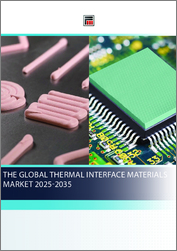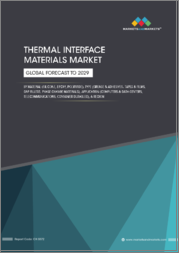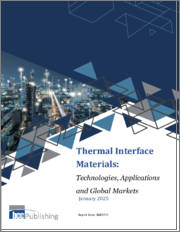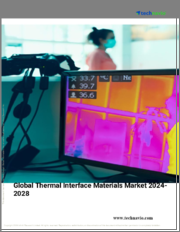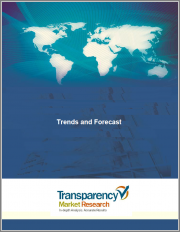
|
시장보고서
상품코드
1541192
세계의 열 인터페이스 재료 시장 보고서 : 제품 유형, 용도, 지역별(2024-2032년)Thermal Interface Materials Market Report by Product Type, Application, and Region 2024-2032 |
||||||
세계의 열 인터페이스 재료 시장 규모는 2023년 35억 달러에 달했습니다. 향후 IMARC 그룹은 시장이 2032년까지 73억 달러에 이르며, 2024년과 2032년 사이에 8.3%의 성장률(CAGR)을 나타낼 것으로 예측했습니다. 이 시장은 가전 분야의 현저한 성장, 재생 가능 에너지 투자 증가, 자동차 기술의 지속적인 발전, 5G 기술 채택 확대, 항공우주 및 방위 분야의 급속한 확대, 의료기기 혁신에 대한 주력 강화 등이 주요 요인입니다.
열 인터페이스 물자 시장 분석 :
주요 시장 성장 촉진요인: 전자 부품의 소형화에 의한 효율적인 방열에 대한 요구 증가와 강력한 컴퓨팅 디바이스에 대한 수요 증가가 열 인터페이스 재료(TIM) 세계 시장을 견인하고 있습니다. 또한 전기자동차(EV)와 신재생에너지 시스템의 채용이 증가하고 있기 때문에 배터리의 성능과 신뢰성을 높이는 첨단 열 관리 솔루션이 필요합니다.
주요 시장 동향 : TIM과 같은 고급 열 관리 솔루션을 필요로 하는 통신 인프라의 확대로 5G 기술의 보급은 시장의 중요한 동향입니다. 작고 효율적인 열 관리 솔루션을 필요로 하는 웨어러블 기술과 사물 인터넷(IoT) 장치의 상당한 개척도 시장의 큰 동향입니다.
지리적 동향 : 아시아태평양은 급속한 산업화, 전자 분야 확대, 중국, 일본, 한국 등 주요 제조 기지의 존재로 시장을 선도하고 있습니다. 이 지역의 이점은 유리한 정부 정책과 기술 진보에 대한 엄청난 투자로 강화되었으며, 이는 다양한 용도에서 TIM 수요를 촉진하고 있습니다. 열 인터페이스 재료 시장 개요는 세계 시장 형성에서 아시아태평양의 중요한 역할을 밝혔습니다.
경쟁 구도 : 시장 경쟁 구도은 3M Company, Dow Inc., Henkel AG & Co.KGaA, Honeywell International Inc., Indium Corporation, Kitagawa Industries America Inc., Laird Technologies Inc. Momentive Performance Materials Inc., Parker- Hannifin Corporation, Zalman Tech Co.Ltd. 등입니다. 이러한 주요 기업은 제품 포트폴리오를 혁신하고 확장하기 위해 연구 개발에 많은 투자를 하고 있습니다. 그들의 노력은 더 큰 시장 점유율을 얻고 효율적인 열 관리 솔루션에 대한 수요 증가에 대응하기 위한 것입니다. 이러한 활동의 결과, 성장과 발전의 기회가 많이 태어나 업계의 역동적이고 경쟁적인 성질이 나타났습니다.
과제와 기회: 시장은 신기술에 따른 재료 혁신의 필요성 증가와 친환경 제품 제조에 대한 압력 증가 등 여러 과제에 직면하고 있습니다. 그러나 이러한 과제는 큰 성장 기회를 초래합니다. 신재생에너지 및 전기자동차(EV)와 같은 신흥 용도의 성장에는 보다 진보된 열 기술이 필요합니다. TIM은 보다 효율적이고 지속가능한 기술을 추구하는 각 산업에서 빠르게 채택되고 있으며, 시장은 여러 분야에서 수많은 성장과 기회를 제공합니다. 이러한 역학은 기술 혁신과 성장을 위한 최근 시장 기회를 부각시키고 진화하는 기술과 환경 상황에서 업계를 유망한 미래로 자리매김하고 있습니다.
열 인터페이스 물자 시장 동향 :
소비자 일렉트로닉스 분야의 현저한 성장
고성능 전자기기에 대한 대중 수요 증가가 시장을 견인하고 있습니다. 전자기기의 소형화와 고성능화에 따라, 그 성능과 수명을 유지하기 위해서는 효과적인 방열이 불가결해지고 있습니다. TIM은 부품과 방열판 사이의 열 전도성을 향상시켜 열을 관리하는 데 필수적인 요소입니다. 이 요구는 최신 TIM이 더 높은 신뢰성과 효율성을 보장하는 가전, 자동차 및 통신 업계에서 특히 두드러집니다. 이러한 모든 추세는 고성능 컴퓨팅 장치 및 게임 외에도 첨단 열 관리 솔루션에 대한 수요를 높이고 있습니다. 그 결과, 열 인터페이스 재료 시장 예측은 여전히 긍정적이며, 지속적인 진보가 확대를 이끌고 있습니다.
신재생에너지 투자 증가
신재생에너지원 개척을 위한 투자 확대가 시장 성장을 지원하고 있습니다. 태양광 발전 및 풍력 발전과 같은 재생 가능 에너지로의 전환은 효율적인 열 관리를 필요로 하는 첨단 전자 시스템의 도입을 수반합니다. 태양광 인버터, 풍력 터빈 컨트롤러 및 기타 관련 장비와 같은 파워 일렉트로닉스 장비는 작동 중에 상당한 양의 열을 발생하므로 성능 요구 사항을 충족시키기 위해 고성능 TIM을 사용해야 합니다. 이는 지속가능한 에너지에 대한 지속적인 관심과 이산화탄소 배출량을 줄이기 위해 신재생에너지를 활용하는 세계 동향으로 인해 재생가능 에너지 프로젝트를 위한 열 인터페이스 재료의 사용을 자극합니다. 하고 있습니다. 신재생에너지 분야가 성장함에 따라 하이테크 열관리 솔루션에 대한 수요는 지속적으로 증가하고 있으며, 그 결과 열 인터페이스 재료에 대한 수요도 크게 증가하고 있습니다.
자동차 기술의 끊임없는 진보
신차 개발의 새로운 기술 혁신은 세계 시장을 자극하는 중요한 요소입니다. 전기자동차 및 자동 운전 차량의 인기가 높아짐에 따라 효과적인 열 관리 솔루션에 대한 수요가 높아지고 있습니다. 배터리와 ECU는 엄격한 온도 관리가 필요하기 때문에 열 관리는 전기자동차에 특히 중요합니다. TIM의 사용은 이러한 부품의 열 설계를 조정하고 전기자동차의 효율성과 안전성을 높이는 데 필수적입니다. 또한 최근 자동차에는 ADAS와 인포테인먼트 등의 기능이 탑재되어 있으며, 그 동작에는 적절한 열 관리가 필요합니다. 이 동향은 열 인터페이스 재료 시장의 성장에 더욱 기여하고 있습니다.
열 인터페이스 재료 시장의 세분화:
IMARC Group은 시장의 각 부문에서 주요 동향을 분석하고 2024년부터 2032년까지 세계, 지역 및 국가 차원의 예측을 제공합니다. 이 보고서는 제품 유형과 용도에 따라 시장을 분류합니다.
제품 유형별 내역
테이프와 필름
엘라스토머 패드
그리스와 접착제
상 변화 재료
금속 기반 재료
기타
그리스와 접착제가 시장 점유율의 대부분을 차지
본 보고서에서는 제품 유형별로 시장을 상세하게 구분·분석했습니다. 여기에는 테이프 필름, 엘라스토머 패드, 그리스 접착제, 상변화물질, 금속 베이스 재료 등이 포함됩니다. 보고서에 따르면 그리스와 접착제가 가장 큰 부문을 차지합니다.
그리스와 접착제는 높은 열전도성과 적용하기 쉬운 특성으로 시장을 독점하고 있습니다. 그리스는 높은 열 성능을 가지며 표면 사이의 작은 틈을 채우고 효율적인 열 전달을 보장합니다. 대조적으로 접착제는 열 전도성과 기계적 접착 능력을 결합하여 다양한 용도에 적합합니다. 그 결과 이러한 제품은 성능과 다용도로 TIMs 시장에서 큰 점유율을 차지합니다. 다양한 산업에서 고성능 장치에 대한 수요가 증가하고 있기 때문에 그리스와 접착제는 앞으로도 높은 수익을 올릴 것으로 예상됩니다.
용도별 내역
통신
컴퓨터
의료기기
산업기계
내구 소비재
자동차 전자
기타
컴퓨터가 업계 최대 점유율
이 보고서는 용도별 시장 분석 및 분석도 자세히 설명합니다. 여기에는 통신, 컴퓨터, 의료기기, 산업기계, 내구 소비재, 자동차 전자 제품 등이 포함됩니다. 보고서에 따르면 컴퓨터는 가장 큰 시장 점유율을 차지합니다.
컴퓨터 분야가 가장 큰 점유율을 차지합니다. 고성능 컴퓨팅(HPC)에 대한 수요 증가와 전자 모듈의 소형화가 열 제거 혁신의 원동력이 되고 있습니다. 보다 빠른 프로세서와 강력한 그래픽 카드 개발과 같은 컴퓨터 프로세서의 진보가 진행됨에 따라 효과적인 열 관리 솔루션에 대한 수요가 증가하고 있습니다. 또한, 게이밍 PC, 워크스테이션, 데이터센터 등의 용도가 확대되고 있는 것도 고성능 TIM 수요를 더욱 가속화하고 있습니다. 열 인터페이스 재료 시장 전망은 이러한 기술의 진보와 컴퓨터 시스템의 복잡성으로 인해 여전히 양호합니다.
지역별 분석
북미
미국
캐나다.
아시아태평양
중국
일본
인도
한국
호주
인도네시아
기타
유럽
독일
프랑스
영국
이탈리아
스페인
러시아
기타
라틴아메리카
브라질
멕시코
기타
중동 및 아프리카
아시아태평양이 시장을 선도하고 최대 점유율을 차지하는 열 인터페이스 재료 시장
또한 북미(미국, 캐나다), 아시아태평양(중국, 일본, 인도, 한국, 호주, 인도네시아 등), 유럽(독일, 프랑스, 영국, 이탈리아, 스페인, 러시아, 기타), 라틴아메리카(브라질, 멕시코, 기타), 중동 및 아프리카를 포함한 주요 지역 시장의 종합적인 분석도 실시했습니다. 이 보고서에 따르면 아시아태평양은 열 인터페이스 재료로 가장 규모가 큰 지역 시장을 차지합니다.
아시아태평양은 급속한 산업화, 전자 산업의 현저한 성장, 중국, 일본, 한국 등 주요 제조 기지의 확대로 시장에서 가장 큰 부문을 차지하고 있습니다. 또한 이 지역에서는 가전, 자동차용 전자기기, 기타 첨단기술의 생산이 증가하고 있는 것도 이 제품 수요를 뒷받침하고 있습니다. 게다가 주요 기업들의 EV 생산과 혁신에 대한 지속적인 투자는 열 인터페이스 재료 시장 강화에 큰 역할을 하고 있습니다.
경쟁 구도:
시장 조사 보고서는 시장 경쟁 구도에 대한 종합적인 분석을 제공합니다. 모든 주요 기업의 상세 프로파일도 제공합니다. 열 인터페이스 재료 산업의 주요 시장 기업은 3M Company, Dow Inc., Henkel AG & Co.KGaA, Honeywell International Inc., Indium Corporation, Kitagawa Industries America Inc., Laird Technologies Inc. Momentive Performance Materials Inc., Parker-Hannifin Corporation, Zalman Tech Co.Ltd. 등이 있습니다
(또한 이것은 주요 기업의 일부 목록이며 전체 목록은 보고서에 설명되어 있습니다).
주요 열 인터페이스 재료 기업은 보다 우수한 열전도성, 신뢰성, 설치성을 특징으로 하는 보다 새롭고 우수한 TIM 개발을 목표로 연구개발에 많은 자원을 나누고 있습니다. 여기에는 다양한 산업 분야 시장 요구가 증가함에 따라 열저항 감소 및 열 내구성 향상과 같은 특성을 개선한 기판, 접착제 및 보호 코팅을 준비하는 것이 포함됩니다. 게다가, 일부 기업들은 세계 전개를 촉진하기 위해 사업, 합병, 인수를 추진하고 있습니다. 이러한 협력 관계는 각 비즈니스 파트너의 강점을 이해하는 데 비즈니스를 지원하며, 그 결과 열 관리 솔루션에 최첨단 기술을 정확하게 제공하는 데에도 도움이 되기 때문입니다. 열 인터페이스 재료 시장 최근 동향을 보면 일부 시장 기업은 환경 친화적이고 지속 가능한 TIM을 출시합니다. 또한 투자에 대한 최대의 이익을 얻기 위해 생산 라인의 디지털화와 산업 발전에 특별한주의를 기울이고 있습니다. 게다가 나노기술 등의 첨단 재료와 기술의 끊임없는 도입도 증가 경향이 있어 시장을 확대하고 있습니다.
열 인터페이스 재료 시장 뉴스
2023년 2월 21일, Indium Corporation은 미국 애리조나 주 메사에서 3월 5일부터 8일까지 개최되는 TestConX에서 번인 및 테스트용 고성능 금속 열 인터페이스 재료(TIM)를 전시한다고 발표 했습니다. 인듐 함유 TIM에는 순인듐, 인듐-은 합금, 인듐-주석이 있습니다.
Resonac Corporation는 2024년 3월 29일 주로 인공지능(AI)용 CPU로 사용되는 고성능 반도체 칩용 재료의 생산 능력을 현재의 3.5-5배로 끌어올리기로 결정했다고 발표했습니다. 비전도성 필름(NCF)과 열전도성 계면 재료(TIM)의 생산을 확대하는 것이 목표입니다. 이러한 재료를 생산하기 위해 150억엔의 설비 투자를 계획하고 있으며, 2024년 이후에 확장 설비의 가동을 개시할 예정입니다.
이 보고서에서 다루는 주요 질문
- 2023년 세계의 열 인터페이스 재료 시장 규모는?
- 2024-2032년 세계의 열 인터페이스 재료 시장의 예상 성장률은?
- 열 인터페이스 재료 시장 세계 시장을 견인하는 주요인은 무엇인가
- 세계의 열 인터페이스 재료 시장에 대한 COVID-19의 영향은?
- 세계의 열 인터페이스 재료 시장의 제품 유형별 내역은?
- 세계의 열 인터페이스 재료 시장의 용도별 내역은?
- 세계의 열 인터페이스 재료 시장의 주요 지역은?
- 열 인터페이스 재료 시장의 세계에서 주요 기업/기업은?
목차
제1장 서문
제2장 조사 범위와 조사 방법
- 조사의 목적
- 이해관계자
- 데이터 소스
- 1차 정보
- 2차 정보
- 시장 추정
- 상향식 접근
- 하향식 접근
- 조사 방법
제3장 주요 요약
제4장 소개
- 개요
- 주요 업계 동향
제5장 세계의 열 인터페이스 재료 시장
- 시장 개요
- 시장 실적
- COVID-19의 영향
- 시장 예측
제6장 시장 내역: 제품 유형별
- 테이프와 필름
- 시장 동향
- 시장 예측
- 엘라스토머 패드
- 시장 동향
- 시장 예측
- 그리스와 접착제
- 시장 동향
- 시장 예측
- 상변화물질
- 시장 동향
- 시장 예측
- 금속계 재료
- 시장 동향
- 시장 예측
- 기타
- 시장 동향
- 시장 예측
제7장 시장 분석 : 용도별
- 통신
- 시장 동향
- 시장 예측
- 컴퓨터
- 시장 동향
- 시장 예측
- 의료기기
- 시장 동향
- 시장 예측
- 산업기계
- 시장 동향
- 시장 예측
- 내구 소비재
- 시장 동향
- 시장 예측
- 자동차 일렉트로닉스
- 시장 동향
- 시장 예측
- 기타
- 시장 동향
- 시장 예측
제8장 시장 분석 : 지역별
- 북미
- 미국
- 캐나다
- 아시아태평양
- 중국
- 일본
- 인도
- 한국
- 호주
- 인도네시아
- 기타
- 유럽
- 독일
- 프랑스
- 영국
- 이탈리아
- 스페인
- 러시아
- 기타
- 라틴아메리카
- 브라질
- 멕시코
- 기타
- 중동 및 아프리카
- 시장 동향
- 시장 분석 : 국가별
- 시장 예측
제9장 SWOT 분석
- 개요
- 강점
- 약점
- 기회
- 위협
제10장 밸류체인 분석
제11장 Porter's Five Forces 분석
- 개요
- 구매자의 협상력
- 공급기업의 협상력
- 경쟁도
- 신규 진입업자의 위협
- 대체품의 위협
제12장 가격 지표
제13장 경쟁 구도
- 시장 구조
- 주요 기업
- 주요 기업 프로파일
- 3M Company
- Dow Inc.
- Henkel AG & Co. KGaA
- Honeywell International Inc.
- Indium Corporation
- Kitagawa Industries America Inc.
- Laird Technologies Inc.
- Momentive Performance Materials Inc.
- Parker-Hannifin Corporation
- Zalman Tech Co., Ltd.
The global thermal interface materials market size reached US$ 3.5 Billion in 2023. Looking forward, IMARC Group expects the market to reach US$ 7.3 Billion by 2032, exhibiting a growth rate (CAGR) of 8.3% during 2024-2032. The market is majorly driven by significant growth in the consumer electronics sector, rising investments in renewable energy, continual advancements in automotive technology, increasing adoption of 5G technology, rapid expansion in aerospace and defense sectors, and an enhanced focus on medical device innovations.
Thermal Interface Materials Market Analysis:
Major Market Drivers: The rising need for efficient heat dissipation due to the miniaturization of electronic components and the augmenting demand for powerful computing devices is driving the global market for thermal interface materials (TIMs). Additionally, the increasing adoption of electric vehicles (EVs) and renewable energy systems requires advanced thermal management solutions to enhance battery performance and reliability.
Key Market Trends: The proliferation of 5G technology due to the expansion of telecommunications infrastructure that demand advanced thermal management solutions such as TIMs is a significant trend in the market. Considerable developments in wearable technologies and the Internet of Things (IoT) devices, which require compact and efficient thermal management solutions, is another major market trend.
Geographical Trends: The Asia Pacific region leads the market, driven by rapid industrialization, expanding electronics sector, and the presence of major manufacturing hubs in countries, such as China, Japan, and South Korea. The region's dominance is bolstered by favorable government policies and significant investments in technological advancements, which fuel the demand for TIMs in various applications. The thermal interface materials market overview highlights the critical role of Asia Pacific in shaping the global market landscape.
Competitive Landscape: The competitive landscape of the market includes leading companies such as 3M Company, Dow Inc., Henkel AG & Co. KGaA, Honeywell International Inc., Indium Corporation, Kitagawa Industries America Inc., Laird Technologies Inc. Momentive Performance Materials Inc., Parker-Hannifin Corporation, and Zalman Tech Co. Ltd. These key players are heavily investing in research and development to innovate and expand their product portfolios. Their efforts aim to capture a larger market share and address the growing demand for efficient thermal management solutions. These activities result in the creation of numerous thermal interface materials market recent opportunities for growth and advancement, showcasing the industry's dynamic and competitive nature.
Challenges and Opportunities: The market faces multiple challenges, such as the augmenting need to innovate materials in line with emerging technologies and the increasing pressure to manufacture environmentally friendly products. However, these challenges also present significant growth opportunities. The growth in emerging applications, such as renewable energy and electric vehicles (EVs), requires more sophisticated thermal technologies. With TIMs being rapidly adopted across industries seeking more efficient and sustainable technologies, the market presents numerous growth and opportunities in multiple sectors. These dynamics highlight the market recent opportunities for innovation and growth, positioning the industry for a promising future amid evolving technological and environmental landscapes.
Thermal Interface Materials Market Trends:
Significant growth in the consumer electronics sector
The rising demand for high-performance electronic devices among the masses is driving the market. As electronic devices become more compact and powerful, effective heat dissipation is crucial to maintain their performance and longevity. TIMs are essential elements in managing heat by improving thermal conductivity between the components and heatsinks. This need is especially noticeable in the consumer electronics, automotive, and telecom industries where modern-day TIMs ensure greater reliability and efficiency. All of these trends are empowering the demand for advanced thermal management solutions, in addition to high-performance computing devices and gaming. As a result, the thermal interface materials market forecast remains positive, with continuous advancements driving its expansion.
Rising Investments in Renewable Energy
The growing investments made for the development of renewable energy sources are supporting the market growth. The transition towards renewable energy, such as solar and wind power, involves the deployment of sophisticated electronic systems that require efficient thermal management. The power electronics equipment such as solar inverters, wind turbine controllers and other associated devices produce considerable amount of heat in course of operation and hence, require the usage of high-performance TIMs to meet the performance requirement. This is due to the continuing interest for sustainable energy and the global trend towards utilizing renewable energy to reduce carbon footprint, thus stimulating the usage of thermal interface materials for renewable energy projects. With the growth of renewable energy sectors, demand for high-tech thermal management solutions is continuously increasing and consequently propelling the thermal interface materials demand significantly.
Continual advancements in automotive technology
Emerging innovations in the development of new vehicles are a significant factor impelling the global market. The rising popularity of electric vehicles and self-driving vehicles has led to the augmenting demand for effective thermal management solutions. Thermal management is particularly crucial for electric vehicles as batteries and ECUs need stringent control of temperature. The use of TIMs is vital in regulating the thermal design of these components and increasing the efficiency and safety of EVs. Also, modern vehicles incorporate features such as ADAS and infotainment that require good thermal management in their operation. This trend is further contributing to the thermal interface materials market growth.
Thermal Interface Materials Market Segmentation:
IMARC Group provides an analysis of the key trends in each segment of the market, along with forecasts at the global, regional, and country levels for 2024-2032. Our report has categorized the market based on product type and application.
Breakup by Product Type:
Tapes and Films
Elastomeric Pads
Greases and Adhesives
Phase Change Materials
Metal Based Materials
Others
Greases and adhesives accounts for the majority of the market share
The report has provided a detailed breakup and analysis of the market based on the product type. This includes tapes and films, elastomeric pads, greases and adhesives, phase change materials, metal-based materials, and others. According to the report, greases and adhesives represented the largest segment.
Greases and adhesives dominate the market due to their high thermal conductivity and easy-to-apply properties. Greases offer high thermal performance and can fill small gaps between surfaces to ensure efficient heat transfer. Adhesives, in contrast, have a combination of thermal conductivity and mechanical bonding capacity, making them suitable for different applications. As a result, these products have a major market share in the TIMs market due to their performance and versatility. On account of the increasing demand for high-performance devices in various industries, greases and adhesives are expected to continue generating high thermal interface materials market revenue.
Breakup by Application:
Telecom
Computer
Medical Devices
Industrial Machinery
Consumer Durables
Automotive Electronics
Others
Computer holds the largest share of the industry
A detailed breakup and analysis of the market based on the application have also been provided in the report. This includes telecom, computer, medical devices, industrial machinery, consumer durables, automotive electronics, and others. According to the report, computer accounted for the largest market share.
The computer segment holds the largest share of the market. Growing demand for high-performance computing (HPC) and the miniaturization of electronic modules drive heat removal innovations. With ongoing advancements in computer processors, including the development of faster processors and more powerful graphics cards, the demand for effective thermal management solutions is rising. Furthermore, the growing usage of gaming PCs, workstations, and data centers further accelerates the demand for high-performance TIMs. The thermal interface materials market outlook remains favorable due to these technological advancements and the increasing complexity of computer systems.
Breakup by Region:
North America
United States
Canada
Asia Pacific
China
Japan
India
South Korea
Australia
Indonesia
Others
Europe
Germany
France
United Kingdom
Italy
Spain
Russia
Others
Latin America
Brazil
Mexico
Others
Middle East and Africa
Asia Pacific leads the market, accounting for the largest thermal interface materials market share
The report has also provided a comprehensive analysis of all the major regional markets, which include North America (the United States and Canada); Asia Pacific (China, Japan, India, South Korea, Australia, Indonesia, and others); Europe (Germany, France, the United Kingdom, Italy, Spain, Russia, and others); Latin America (Brazil, Mexico, and others); and the Middle East and Africa. According to the report, Asia Pacific represents the largest regional market for thermal interface materials.
Asia Pacific holds the largest segment in the market due to the region's rapid industrialization, significant growth of the electronics industries, and the expansion of major manufacturing hubs such as China, Japan, and South Korea. The increasing production of consumer electronics, automotive electronics, and other advanced technologies in this region also drives the demand for the product. Furthermore, continual investments by key players in the production of EVs and technological innovations are further playing a significant role in enhancing the thermal interface materials market.
Competitive Landscape:
The market research report has also provided a comprehensive analysis of the competitive landscape in the market. Detailed profiles of all major companies have also been provided. Some of the major market players in the thermal interface materials industry include 3M Company, Dow Inc., Henkel AG & Co. KGaA, Honeywell International Inc., Indium Corporation, Kitagawa Industries America Inc., Laird Technologies Inc. Momentive Performance Materials Inc., Parker-Hannifin Corporation, and Zalman Tech Co. Ltd.
(Please note that this is only a partial list of the key players, and the complete list is provided in the report.)
Leading thermal interface materials companies are allocating significant amounts of resources towards research and development as they seek to develop newer and better TIMs characterized by better thermal conductivity, reliability, and installation. This comprises of preparing substrates, adhesives, and protective coatings with improved characteristics like reduced thermal resistance and increased thermal endurance to accommodate the increasing market requirements of different industries. Moreover, several companies are promoting businesses, mergers, and acquisitions to promote their global reach as these collaborations assist businesses in understanding the strength of the respective business partners, thus even helping them in bringing cutting-edge technology to thermal management solutions precisely. With reference to thermal interface materials market recent developments, some of the market players are launching environmentally friendly and sustainable TIMs. They are also paying special attention to digital and industrial advancement in production lines to achieve maximum returns on their investments. Additionally, the constant incorporation of advanced materials and technologies such as nanotechnology is also perceived to be on the rise, which is augmenting the market.
Thermal Interface Materials Market News:
On 21st February 2023, Indium Corporation announced that it will feature its high-performance metal thermal interface materials (TIMs) for burn-in and test at TestConX during March 5th to 8th in Mesa, Arizona, U.S. The indium-containing TIMs offer superior thermal conductivity over non-metals with pure indium metal delivering 86W/mK. Its indium-containing TIMs are available as pure indium, indium-silver alloys, and indium-tin.
On 29th March 2024, Resonac Corporation announced the decision to increase its capacity to produce materials for high-performance semiconductor chips, which are to be used mainly as CPUs for artificial intelligence (AI), to 3.5 to 5 times of the current level. The company aims to escalate the production of non-conductive film (NCF) and thermal interface material (TIM). It plans to invest 15 billion yen in facilities to produce these materials and will commence operation of the expanded facilities in and after 2024.
Key Questions Answered in This Report
- 1. What was the size of the global thermal interface materials market in 2023?
- 2. What is the expected growth rate of the global thermal interface materials market during 2024-2032?
- 3. What are the key factors driving the global thermal interface materials market?
- 4. What has been the impact of COVID-19 on the global thermal interface materials market?
- 5. What is the breakup of the global thermal interface materials market based on the product type?
- 6. What is the breakup of the global thermal interface materials market based on the application?
- 7. What are the key regions in the global thermal interface materials market?
- 8. Who are the key players/companies in the global thermal interface materials market?
Table of Contents
1 Preface
2 Scope and Methodology
- 2.1 Objectives of the Study
- 2.2 Stakeholders
- 2.3 Data Sources
- 2.3.1 Primary Sources
- 2.3.2 Secondary Sources
- 2.4 Market Estimation
- 2.4.1 Bottom-Up Approach
- 2.4.2 Top-Down Approach
- 2.5 Forecasting Methodology
3 Executive Summary
4 Introduction
- 4.1 Overview
- 4.2 Key Industry Trends
5 Global Thermal Interface Materials Market
- 5.1 Market Overview
- 5.2 Market Performance
- 5.3 Impact of COVID-19
- 5.4 Market Forecast
6 Market Breakup by Product Type
- 6.1 Tapes and Films
- 6.1.1 Market Trends
- 6.1.2 Market Forecast
- 6.2 Elastomeric Pads
- 6.2.1 Market Trends
- 6.2.2 Market Forecast
- 6.3 Greases and Adhesives
- 6.3.1 Market Trends
- 6.3.2 Market Forecast
- 6.4 Phase Change Materials
- 6.4.1 Market Trends
- 6.4.2 Market Forecast
- 6.5 Metal Based Materials
- 6.5.1 Market Trends
- 6.5.2 Market Forecast
- 6.6 Others
- 6.6.1 Market Trends
- 6.6.2 Market Forecast
7 Market Breakup by Application
- 7.1 Telecom
- 7.1.1 Market Trends
- 7.1.2 Market Forecast
- 7.2 Computer
- 7.2.1 Market Trends
- 7.2.2 Market Forecast
- 7.3 Medical Devices
- 7.3.1 Market Trends
- 7.3.2 Market Forecast
- 7.4 Industrial Machinery
- 7.4.1 Market Trends
- 7.4.2 Market Forecast
- 7.5 Consumer Durables
- 7.5.1 Market Trends
- 7.5.2 Market Forecast
- 7.6 Automotive Electronics
- 7.6.1 Market Trends
- 7.6.2 Market Forecast
- 7.7 Others
- 7.7.1 Market Trends
- 7.7.2 Market Forecast
8 Market Breakup by Region
- 8.1 North America
- 8.1.1 United States
- 8.1.1.1 Market Trends
- 8.1.1.2 Market Forecast
- 8.1.2 Canada
- 8.1.2.1 Market Trends
- 8.1.2.2 Market Forecast
- 8.1.1 United States
- 8.2 Asia Pacific
- 8.2.1 China
- 8.2.1.1 Market Trends
- 8.2.1.2 Market Forecast
- 8.2.2 Japan
- 8.2.2.1 Market Trends
- 8.2.2.2 Market Forecast
- 8.2.3 India
- 8.2.3.1 Market Trends
- 8.2.3.2 Market Forecast
- 8.2.4 South Korea
- 8.2.4.1 Market Trends
- 8.2.4.2 Market Forecast
- 8.2.5 Australia
- 8.2.5.1 Market Trends
- 8.2.5.2 Market Forecast
- 8.2.6 Indonesia
- 8.2.6.1 Market Trends
- 8.2.6.2 Market Forecast
- 8.2.7 Others
- 8.2.7.1 Market Trends
- 8.2.7.2 Market Forecast
- 8.2.1 China
- 8.3 Europe
- 8.3.1 Germany
- 8.3.1.1 Market Trends
- 8.3.1.2 Market Forecast
- 8.3.2 France
- 8.3.2.1 Market Trends
- 8.3.2.2 Market Forecast
- 8.3.3 United Kingdom
- 8.3.3.1 Market Trends
- 8.3.3.2 Market Forecast
- 8.3.4 Italy
- 8.3.4.1 Market Trends
- 8.3.4.2 Market Forecast
- 8.3.5 Spain
- 8.3.5.1 Market Trends
- 8.3.5.2 Market Forecast
- 8.3.6 Russia
- 8.3.6.1 Market Trends
- 8.3.6.2 Market Forecast
- 8.3.7 Others
- 8.3.7.1 Market Trends
- 8.3.7.2 Market Forecast
- 8.3.1 Germany
- 8.4 Latin America
- 8.4.1 Brazil
- 8.4.1.1 Market Trends
- 8.4.1.2 Market Forecast
- 8.4.2 Mexico
- 8.4.2.1 Market Trends
- 8.4.2.2 Market Forecast
- 8.4.3 Others
- 8.4.3.1 Market Trends
- 8.4.3.2 Market Forecast
- 8.4.1 Brazil
- 8.5 Middle East and Africa
- 8.5.1 Market Trends
- 8.5.2 Market Breakup by Country
- 8.5.3 Market Forecast
9 SWOT Analysis
- 9.1 Overview
- 9.2 Strengths
- 9.3 Weaknesses
- 9.4 Opportunities
- 9.5 Threats
10 Value Chain Analysis
11 Porters Five Forces Analysis
- 11.1 Overview
- 11.2 Bargaining Power of Buyers
- 11.3 Bargaining Power of Suppliers
- 11.4 Degree of Competition
- 11.5 Threat of New Entrants
- 11.6 Threat of Substitutes
12 Price Indicators
13 Competitive Landscape
- 13.1 Market Structure
- 13.2 Key Players
- 13.3 Profiles of Key Players
- 13.3.1 3M Company
- 13.3.1.1 Company Overview
- 13.3.1.2 Product Portfolio
- 13.3.1.3 Financials
- 13.3.1.4 SWOT Analysis
- 13.3.2 Dow Inc.
- 13.3.2.1 Company Overview
- 13.3.2.2 Product Portfolio
- 13.3.2.3 Financials
- 13.3.3 Henkel AG & Co. KGaA
- 13.3.3.1 Company Overview
- 13.3.3.2 Product Portfolio
- 13.3.3.3 Financials
- 13.3.3.4 SWOT Analysis
- 13.3.4 Honeywell International Inc.
- 13.3.4.1 Company Overview
- 13.3.4.2 Product Portfolio
- 13.3.4.3 Financials
- 13.3.4.4 SWOT Analysis
- 13.3.5 Indium Corporation
- 13.3.5.1 Company Overview
- 13.3.5.2 Product Portfolio
- 13.3.6 Kitagawa Industries America Inc.
- 13.3.6.1 Company Overview
- 13.3.6.2 Product Portfolio
- 13.3.7 Laird Technologies Inc.
- 13.3.7.1 Company Overview
- 13.3.7.2 Product Portfolio
- 13.3.8 Momentive Performance Materials Inc.
- 13.3.8.1 Company Overview
- 13.3.8.2 Product Portfolio
- 13.3.9 Parker-Hannifin Corporation
- 13.3.9.1 Company Overview
- 13.3.9.2 Product Portfolio
- 13.3.9.3 Financials
- 13.3.9.4 SWOT Analysis
- 13.3.10 Zalman Tech Co., Ltd.
- 13.3.10.1 Company Overview
- 13.3.10.2 Product Portfolio
- 13.3.1 3M Company








